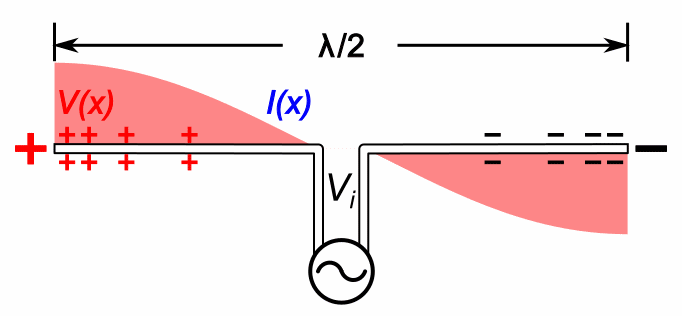Dipole_antenna_standing_waves_animation_6_-_5fps.gif
Summary
| Description Dipole antenna standing waves animation 6 - 5fps.gif |
English:
Animation showing
standing waves
on a
half-wave dipole antenna
driven by a sinusoidal voltage
V
i
from a radio transmitter at its
resonant frequency
. The oscillating voltage pushes the electrons back and forth along the two metal rods that make up the antenna, creating oscillating currents
(
blue arrows
)
in the antenna, charging its ends alternately positive (+) and negative (-). Since at this frequency the antenna is a half
wavelength
(λ/2) long, a sinusoidal wave of voltage or current takes exactly one cycle to make the round trip from one end of the antenna to the other and back, so the reflected waves reinforce each other. The antenna acts like an electronic
resonater
. Waves of current and voltage reflecting back and forth between the ends of the rods interfere to form
standing waves
, which radiate
radio waves
into space. The waves are shown graphically by bars of color (
red for voltage
V
(x)
and
blue for current
I
(x)
) whose width at each point is proportional to the
amplitude
of the wave at that point.
The blue arrows show the direction of
conventional current
, flow of positive charge. The electrons oscillating back and forth in the antenne move in a direction opposite to the arrows. The action is shown slowed down enormously; the currents in an actual antenna oscillate back and forth 20 thousand to one billion times per second.
 between the two antenna elements, driving the oscillations. The energy from this current provides the energy lost in the antenna' s
radiation resistance
which represents the energy radiated as radio waves. Since the antenna is fed at its resonant frequency, the input voltage is in phase with the current (blue bar), so the antenna presents a pure resistance to the feedline. Dipoles have relatively high
Q factor
so the amount of energy stored in the standing waves is large compared to the energy added each cycle by the feedline, the feed voltage just represents a small perturbation to the standing waves. This is why the voltage standing wave is much larger than the voltage step at the feedline. Since the standing waves are storing energy, not transporting power, the current in them is not in phase with the voltage but 90° out of phase
between the two antenna elements, driving the oscillations. The energy from this current provides the energy lost in the antenna' s
radiation resistance
which represents the energy radiated as radio waves. Since the antenna is fed at its resonant frequency, the input voltage is in phase with the current (blue bar), so the antenna presents a pure resistance to the feedline. Dipoles have relatively high
Q factor
so the amount of energy stored in the standing waves is large compared to the energy added each cycle by the feedline, the feed voltage just represents a small perturbation to the standing waves. This is why the voltage standing wave is much larger than the voltage step at the feedline. Since the standing waves are storing energy, not transporting power, the current in them is not in phase with the voltage but 90° out of phase
|
| Date | |
| Source | Own work |
| Author | Chetvorno |
| Other versions |
Dipole antenna standing waves animation 1-10fps.gif - less detail Dipole antenna standing waves animation 6-10fps.gif - faster frame rate |

|
This circuit image could be re-created
using
vector graphics
as an
SVG
file
. This has several advantages; see
Commons:Media for cleanup
for more information. If an SVG form of this image is available, please upload it and afterwards replace this template with
{{
vector version available
|
new image name
}}
.
It is recommended to name the SVG file "Dipole antenna standing waves animation 6 - 5fps.svg" - then the template
Vector version available
(or
Vva
) does not need the
new image name
parameter.
|
Licensing
I, the copyright holder of this work, hereby publish it under the following license:
|
|
This file is made available under the Creative Commons CC0 1.0 Universal Public Domain Dedication . |
|
The person who associated a work with this deed has dedicated the work to the
public domain
by waiving all of their rights to the work worldwide under copyright law, including all related and neighboring rights, to the extent allowed by law. You can copy, modify, distribute and perform the work, even for commercial purposes, all without asking permission.
http://creativecommons.org/publicdomain/zero/1.0/deed.en CC0 Creative Commons Zero, Public Domain Dedication false false |
Captions
Animation showing standing waves of current and voltage on a dipole antenna

